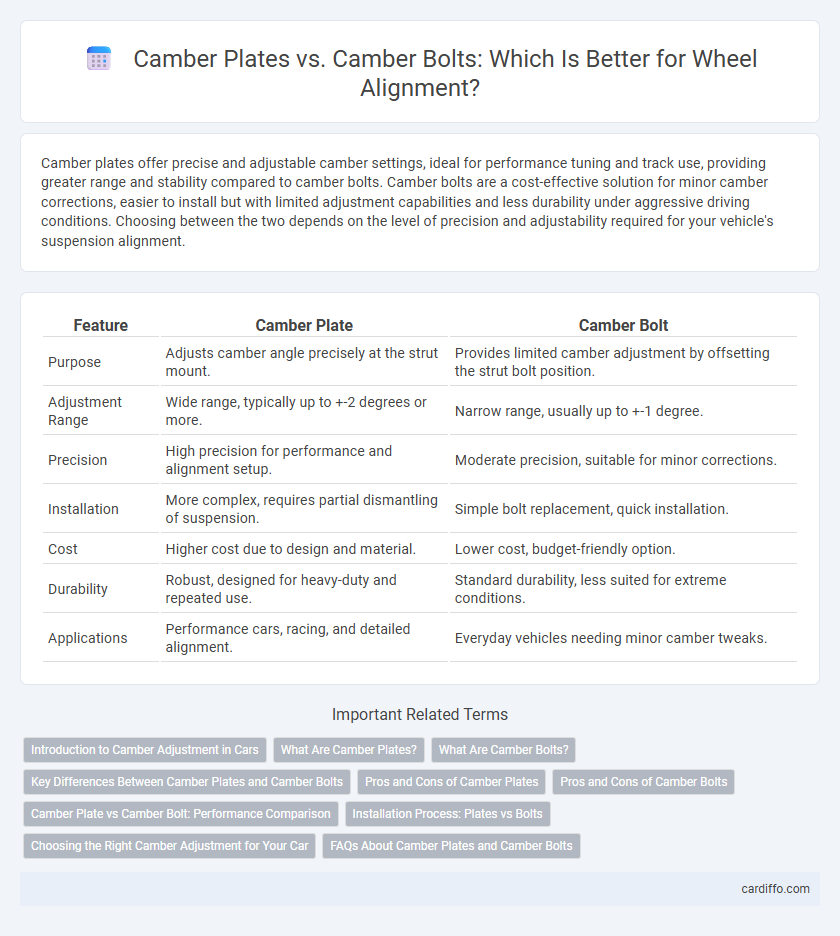Camber plates offer precise and adjustable camber settings, ideal for performance tuning and track use, providing greater range and stability compared to camber bolts. Camber bolts are a cost-effective solution for minor camber corrections, easier to install but with limited adjustment capabilities and less durability under aggressive driving conditions. Choosing between the two depends on the level of precision and adjustability required for your vehicle's suspension alignment.
Table of Comparison
| Feature | Camber Plate | Camber Bolt |
|---|---|---|
| Purpose | Adjusts camber angle precisely at the strut mount. | Provides limited camber adjustment by offsetting the strut bolt position. |
| Adjustment Range | Wide range, typically up to +-2 degrees or more. | Narrow range, usually up to +-1 degree. |
| Precision | High precision for performance and alignment setup. | Moderate precision, suitable for minor corrections. |
| Installation | More complex, requires partial dismantling of suspension. | Simple bolt replacement, quick installation. |
| Cost | Higher cost due to design and material. | Lower cost, budget-friendly option. |
| Durability | Robust, designed for heavy-duty and repeated use. | Standard durability, less suited for extreme conditions. |
| Applications | Performance cars, racing, and detailed alignment. | Everyday vehicles needing minor camber tweaks. |
Introduction to Camber Adjustment in Cars
Camber adjustment in cars primarily involves modifying the angle of the wheels relative to the vertical axis to improve handling and tire wear. Camber plates offer a broader range of adjustment by replacing the strut mount, allowing precise alignment changes for performance tuning. In contrast, camber bolts provide a cost-effective solution with more limited adjustment by enabling minor angle corrections through offset bolt design.
What Are Camber Plates?
Camber plates are adjustable suspension components installed at the top of the vehicle's strut tower, allowing precise modification of camber angles for improved tire contact and handling performance. Unlike camber bolts, which offer limited adjustment by altering the strut position, camber plates provide a broader range of camber change and enhance alignment accuracy. These plates are essential for performance tuning and correcting camber wear in both street and track vehicles.
What Are Camber Bolts?
Camber bolts are specialized fasteners designed to adjust the camber angle of a vehicle's wheels by allowing slight movement within the strut mounting points. These bolts feature an eccentric lobe that shifts the alignment when rotated, providing precise control over wheel tilt to improve handling and tire wear. Unlike camber plates, which replace the strut top mount, camber bolts offer a more cost-effective and simpler method for fine-tuning suspension alignment.
Key Differences Between Camber Plates and Camber Bolts
Camber plates allow for a wider range of suspension angle adjustment by replacing the top strut mount, providing more precise camber correction compared to camber bolts, which offer limited camber change by sliding the strut sideways. Camber plates are typically used in performance and racing applications due to their durability and adjustability, while camber bolts serve as a budget-friendly solution for minor alignment tweaks. The increased adjustability of camber plates helps optimize tire contact patch and improve handling, whereas camber bolts are best suited for standard street driving and light modifications.
Pros and Cons of Camber Plates
Camber plates offer precise and adjustable suspension alignment, allowing for a wider range of camber angles compared to camber bolts, which is especially beneficial for performance and track-focused vehicles. They provide improved handling and tire wear by enabling fine-tuning of wheel alignment but tend to be more expensive and complex to install than camber bolts. Unlike camber bolts, camber plates may introduce slight noise or loosen over time if not properly maintained.
Pros and Cons of Camber Bolts
Camber bolts offer easy adjustability for precise alignment without requiring special tools or components, making them cost-effective for minor alignment corrections. However, they provide limited adjustability range compared to camber plates and may reduce suspension stability under extreme driving conditions due to potential bolt shift. Their installation is straightforward, but over-tightening can lead to premature wear or damage, making proper torque application essential.
Camber Plate vs Camber Bolt: Performance Comparison
Camber plates offer superior adjustability and precision in alignment settings compared to camber bolts, allowing for a wider range of camber angle correction essential for optimal tire contact and handling performance. Camber bolts provide a simpler, more cost-effective solution with limited adjustment range, making them suitable for minor alignment tweaks but less effective in high-performance or track applications. Vehicles requiring aggressive alignment settings and improved cornering stability benefit significantly from the enhanced performance capabilities of camber plates over camber bolts.
Installation Process: Plates vs Bolts
Camber plates require removing the strut tower and replacing the factory mount, often involving precise adjustments with camber bolts integrated into the plate design. Camber bolts install directly onto the existing suspension components, allowing for quicker, less invasive camber angle adjustments without disassembling the strut assembly. The plate system offers a broader adjustment range and more solid mounting, while bolts provide simpler installation suited for minor camber corrections.
Choosing the Right Camber Adjustment for Your Car
Camber plates offer a greater range of camber adjustment and improved suspension articulation compared to camber bolts, making them ideal for performance-oriented vehicles and track use. Camber bolts provide a cost-effective solution for slight camber corrections, suitable for everyday driving and minor alignment tweaks. Selecting the right camber adjustment depends on your driving style, suspension setup, and desired precision in alignment settings.
FAQs About Camber Plates and Camber Bolts
Camber plates and camber bolts are essential components for adjusting the camber angle in vehicle suspension systems, with camber plates offering greater adjustability and precision compared to camber bolts. Common FAQs address compatibility with different car models, installation complexity, and the impact on tire wear and handling performance. Camber plates are preferred for performance tuning due to their enhanced range of adjustment, while camber bolts provide an easier, cost-effective solution for minor alignment corrections.
Camber Plate vs Camber Bolt Infographic

 cardiffo.com
cardiffo.com